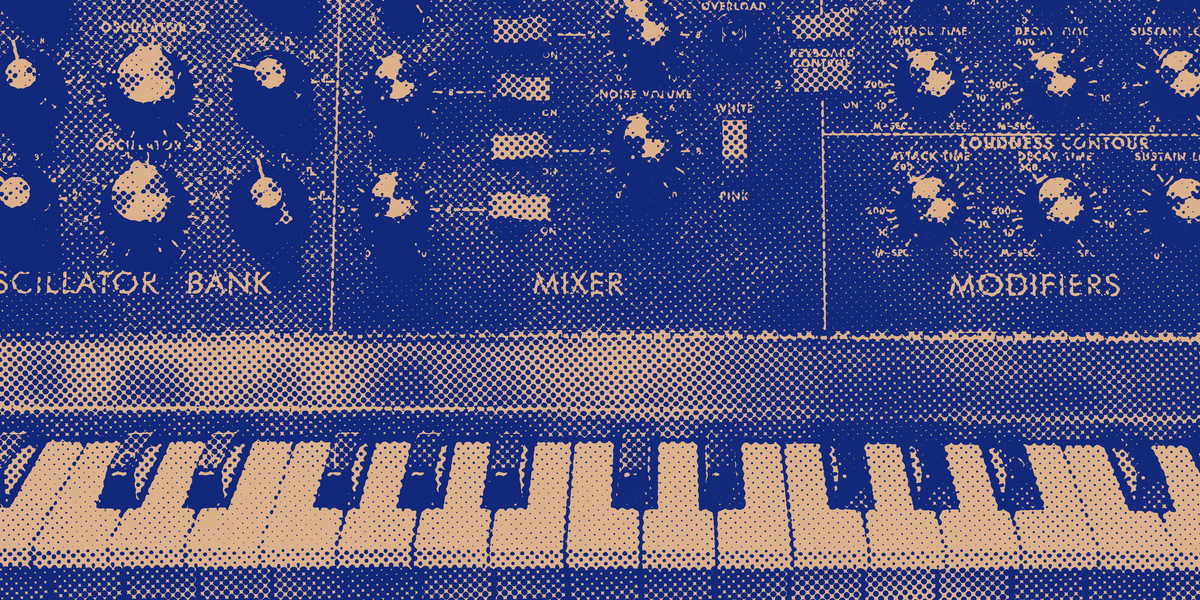The legendary Moog Minimoog Model-D (that almost never was)
The most important synthesizer of a generation is one that almost didn't exist in the way we remember it. The story of the Minimoog Model-D.

There are some instruments that enter the collective cultural zeitgeist slowly and with a steady rate of evolution. Think of the banjo, the piano, or that horrible little plastic recorder that the neighbour's kid is playing "Three Blind Mice" on over and over. But sometimes, if we're lucky, a new instrument smashes into popular culture hard and fast, and we forever attribute it a universal shorthand from which future myths are made. Think of the Stratocaster or... the Moog. When we say "Moog" we nearly always mean the "Moog Minimoog Model-D". An iconic instrument that brought about a new era of music production and marked the beginning of a new epoch in the history of music. But an instrument that almost never was. This is its story.
The Birth of a Legend
At the heart of the Moog Model D synthesizer lies the visionary genius of Dr. Robert Moog. In the 1960s, Dr. Moog embarked on a mission to unlock the untapped potential of electronic music. His passion for both electronics and music converged, leading him to develop groundbreaking instruments that would forever change the course of music history.
Driven by his insatiable curiosity and tireless experimentation, Dr. Moog's journey began with the development of the iconic Moog modular synthesizer system. Through years of research and collaboration with pioneering musicians and engineers, Dr. Moog refined his designs and perfected the technology that would eventually culminate in the birth of the Model D.
The dawn of a new era (in sound)
Before the Minimoog's inception, synthesizers were seen as an elusive luxury, accessible only to a select few. Large, expensive, and enormously complex, they were predominantly owned by universities or record labels. These behemoths were predominantly used to create soundtracks or jingles, with their high cost and complexity making them inaccessible to ordinary people. Modular synthesizers of the time required users to manually connect components with patch cables to create sounds, which further increased their difficulty to use. Adding to their unreliability and impracticality, these machines were sensitive to temperature and humidity, making them even more challenging to operate.
Recognizing the need for a more accessible and user-friendly synthesizer, Moog engineer Bill Hemsath embarked on a mission to create a smaller, more reliable version of these titanic machines. He constructed a prototype by sawing a keyboard in half and wiring several components into a compact cabinet. Despite initial skepticism from Moog's president, Robert Moog, the prototype sparked interest, leading to further development and refinement. The urgency to create a commercially viable product increased as the company began facing financial challenges due to falling interest in its modular synthesizers. This fear of job loss pushed the engineers to develop what would become the Minimoog Model D.
The revolutionary Minimoog Model D
The Minimoog Model D, first introduced to the world in 1970, was a marvel of its time. It was designed as a more affordable, portable version of the modular Moog synthesizer, bringing the power of synthesizers within the grasp of a much larger audience. This groundbreaking synthesizer housed three oscillators, which due to an issue with the power supply, were never completely synchronized. This 'issue' resulted in the creation of a warm, rich sound that has since become a defining characteristic of the Minimoog Model D. The synthesizer also featured a unique voltage-controlled filter, enabling users to shape sounds across a broad spectrum, from funky bass blurps to spacey whistle lead tones. The Minimoog Model D was also the first synthesizer to introduce a pitch wheel, allowing musicians to bend notes much like a guitarist or a saxophonist, offering a new level of expressive playing.
The Minimoog Model D quickly became a sensation among musicians across various genres. As the first synthesizer to be sold in retail stores, it found a home in disco, pop, rock, electronic music, progressive rock, and jazz. Its versatility and unique sound profile were embraced by some of the world's most influential artists. Musicians such as Trent Reznor, Gary Numan, Dr. Dre, Keith Emerson, Herbie Hancock, Kraftwerk, Sun Ra, P-Funk, Giorgio Moroder, and Nine Inch Nails have used the Minimoog Model D to shape their unique sounds and forge new musical genres, illustrating the instrument's far-reaching influence.
Anatomy of the Model D
To truly appreciate the impact of the Moog Model D, one must explore its intricate design and the unique capabilities that set it apart. The Model D is a monophonic analog synthesizer with a distinct layout that showcases its powerful modules and intuitive controls.
The heart of the Model D lies in its three voltage-controlled oscillators (VCOs), which generate a wide range of waveforms, including the iconic sawtooth, triangle, and pulse waves. These oscillators provide musicians with the foundation for creating rich and diverse sonic textures. The Model D's oscillator section also features frequency modulation capabilities, allowing for intricate and harmonically complex timbres.
In the signal path of the Model D, the sound then passes through its legendary resonant low-pass filter. Renowned for its warm and expressive character, the filter is responsible for sculpting and shaping the sound, giving it a distinctive and recognizable character. The filter's cutoff frequency, resonance, and envelope settings provide musicians with unparalleled control over the harmonic content and dynamics of their sound.
Complementing the oscillators and filter, the Model D features envelope generators (ADSR) for both the amplifier and filter sections. These envelope generators allow musicians to shape the volume and timbre of the sound over time, enabling the creation of dynamic and expressive performances.
The Model D's control panel is a testament to Dr. Moog's commitment to user-friendliness and accessibility. Each knob and switch has been meticulously placed and labeled, allowing for quick and intuitive adjustments. This hands-on interface invites musicians to interact with the synthesizer, encouraging exploration and experimentation.
Additionally, the Model D features a range of connectivity options, including external audio input, modulation inputs, and outputs for integrating with other modular or analog gear. This flexibility further enhances the Model D's versatility, enabling musicians to create intricate and interconnected soundscapes.
Together, the oscillators, filter, envelope generators, and control panel of the Moog Model D form a cohesive and powerful instrument. Its design, rooted in Dr. Moog's relentless pursuit of sonic excellence, has earned the Model D its revered status as a legendary analog synthesizer.
The Sound of Innovation
The Moog Model D synthesizer's impact goes far beyond its physical design. Its sound is what truly captivates musicians and listeners alike. The combination of its oscillators, filters, and modulation options allows for a vast sonic palette that is both expressive and captivating.
The three voltage-controlled oscillators (VCOs) in the Model D generate a range of waveforms, each with its own unique timbre. The sawtooth waveform delivers a rich and bright sound, while the triangle waveform offers a softer and more mellow character. The pulse waveform, with its adjustable width, provides versatility, allowing for sharp and cutting tones or gentle and smooth textures. Musicians can combine these waveforms and fine-tune their frequencies to create intricate and layered sounds.
Central to the Model D's iconic sound is its resonant low-pass filter. The filter's unique ability to remove or emphasize specific frequencies imparts a warm and organic character to the sound. By adjusting the cutoff frequency and resonance settings, musicians can shape the tone, sculpting it from mellow and rounded to bright and biting. The filter's self-oscillation feature allows it to generate pure tones, expanding the Model D's sonic possibilities even further.
Modulation plays a crucial role in adding movement and dynamics to the sound. The Model D offers modulation options such as vibrato, oscillator sync, and frequency modulation. These capabilities allow for evolving textures, subtle nuances, and complex timbral changes that bring life and expression to the music created with the synthesizer.
The Model D's sound has left an indelible mark on music history. Its warm, fat, and distinctive tones have graced countless recordings across genres, from the soaring lead lines of progressive rock to the funky basslines of disco and the atmospheric soundscapes of ambient music. From Wendy Carlos' groundbreaking album "Switched-On Bach" to the iconic Moog-driven melodies of Keith Emerson, the Model D's sound has shaped the sonic landscape of popular music.
Influence on Music and Beyond
The Moog Model D's influence extends far beyond its impact on individual recordings. Its introduction ushered in a new era of music production, pushing the boundaries of what was thought possible. The Model D became the catalyst for the exploration of new sonic territories and the birth of entire musical genres.
During the late 1960s and early 1970s, the Model D found a home in the hands of pioneering musicians who were drawn to its expressive capabilities. Keith Emerson of Emerson, Lake & Palmer used the Model D to create symphonic and progressive rock masterpieces, pushing the boundaries of keyboard-driven music. The iconic basslines in songs like Stevie Wonder's "Living for the City" and Parliament's "Flash Light" were born out of the Model D's rich low-end and distinctive filter sound.
The Model D also played a significant role in the rise of electronic and dance music. Artists like Kraftwerk, Giorgio Moroder, and Donna Summer utilized its distinctive sound to craft infectious grooves and futuristic textures, paving the way for the electronic music revolution. From the birth of disco to the emergence of techno, the Model D became a staple in the studios and live performances of electronic music pioneers.
Beyond the realm of music, the Model D's impact resonated in the wider cultural landscape. Its association with the counterculture movement of the 1960s and 1970s symbolized a shift toward experimentation, self-expression, and the breaking of traditional musical boundaries. The Model D's allure crossed genres, captivating not only musicians but also filmmakers, sound designers, and artists seeking new ways to convey emotions and narratives through sound.
The Moog Model D continues to inspire musicians and shape contemporary music. Its sound and legacy can be heard in the countless modern synthesizers and software emulations that seek to capture its essence. Whether in the hands of seasoned professionals or aspiring musicians, the Model D remains a source of inspiration, innovation, and endless sonic exploration.
Modern Emulations, Reissues, and Clones
The Moog Model D synthesizer's iconic sound and revered status have led to a continued demand for its distinct sonic capabilities. Recognizing this enduring popularity, various companies have developed modern emulations, reissues, and clones of the Model D, ensuring that its legendary sound remains accessible to musicians today.
Software emulations have emerged as a popular option, allowing musicians to harness the power of the Model D within their digital audio workstations (DAWs). These virtual instruments painstakingly recreate the characteristics and sonic nuances of the original Model D, offering an authentic analog experience in the digital realm. With precise modeling of oscillators, filters, and modulation options, these software emulations capture the essence of the Model D's sound, enabling musicians to integrate its iconic tones into their modern production workflows.
In addition to software emulations, Moog Music itself has recognized the demand for the Model D's sound and reintroduced the instrument with a faithful reissue. Using original schematics and designs, Moog Music meticulously recreates the Model D, allowing musicians to experience the magic of the iconic synthesizer firsthand. These reissues capture the essence of the original Model D, with its distinctive sound, layout, and build quality. Musicians can once again embrace the tactile experience of interacting with the physical knobs and switches, diving into the world of analog synthesis.
Furthermore, the popularity of the Model D has spurred the development of clones and reimaginations by various boutique manufacturers. These instruments offer their own take on the Model D's circuitry, often incorporating modern enhancements while staying true to the essence of the original. These clones provide an opportunity for musicians to access the Model D's sound and design philosophy at varying price points, making its iconic tones more accessible to a broader range of users.
Whether through software emulations, reissues, or clones, these modern interpretations of the Model D showcase its enduring influence and popularity. They enable musicians of all backgrounds and budgets to experience the unmistakable sound and creative potential that have made the Model D a legendary synthesizer.
It is worth noting that while these modern alternatives capture the essence of the Model D, each iteration carries its own unique characteristics and sonic nuances. Musicians are presented with a range of options, allowing them to choose the instrument that best aligns with their artistic vision, workflow, and sonic preferences.
The availability of modern emulations, reissues, and clones ensures that the Model D's sound remains accessible to musicians in the digital age. These instruments honor the rich legacy of the original Model D while introducing new possibilities for exploration and innovation. As technology continues to advance, the spirit of the Model D lives on, inspiring musicians to create groundbreaking music and forge new sonic frontiers.
The Model D Community
One of the remarkable aspects of the Moog Model D synthesizer is the vibrant and passionate community that has formed around it. Musicians, enthusiasts, and collectors have come together to share their love for this iconic instrument.
Online forums, social media groups, and dedicated websites have become hubs for Model D enthusiasts to connect, exchange knowledge, and share their experiences. Musicians discuss their favorite techniques, share sound design tips, and showcase their compositions created with the Model D. Vintage gear enthusiasts offer advice on maintenance, repair, and modifications, ensuring that these treasured instruments continue to thrive.
In addition to online communities, Model D gatherings and meetups take place in various cities, where users can come together to share their love for this legendary synthesizer. These events often feature performances, workshops, and hands-on opportunities to explore the Model D and its sonic possibilities.
The Model D community embodies a spirit of creativity, collaboration, and a deep appreciation for the instrument's unique qualities. The shared enthusiasm and passion for the Model D serve to inspire and support musicians in their exploration of its sonic landscape, fostering a sense of camaraderie and connection among its dedicated users.
The Enduring Legacy of the Minimoog Model D
Despite its success, the Minimoog Model D's production came to a halt in the early 1980s due to financial constraints. However, this did not mark the end of its influence. The instrument's cultural significance and impact on music persisted, and the demand for this legendary synthesizer remained high. Vintage '70s models of the Minimoog Model D can fetch up to $10,000, and even the reissues often sell for over $7,000. Its popularity led to subsequent reissues, including one in 2016 and another in 2022, over fifty years after its original debut.
In the annals of music history, the Minimoog Model D stands as a monument to innovation, accessibility, and artistic expression. Its unique design, innovative features, and the distinctive sounds it can produce have made it an integral part of the music industry. From shaping the soundscapes of various music genres to influencing the works of numerous artists, the Minimoog Model D has made an indelible mark on the world of music.
Even today, more than half a century after its conception, the Minimoog Model D continues to hold a revered place in the world of music. Its enduring legacy is a testament to its revolutionary design and far-reaching influence. The Minimoog Model D is not just a synthesizer; it is an emblem of musical evolution and a key catalyst in the rise of electronic music. Its story is a testament to the power of innovation and the enduring impact of well-crafted instruments in shaping the course of music history.
So, here's to the Minimoog Model D – a true game-changer that transformed the sound of music and continues to inspire artists and music enthusiasts around the globe.


